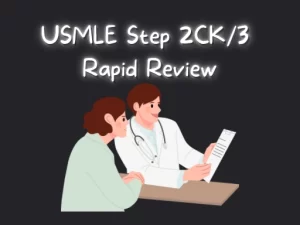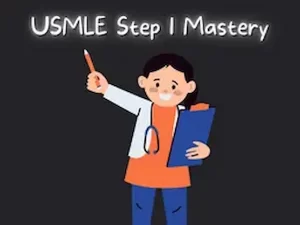Studying for the USMLE in 2025 isn’t just about thick textbooks and late-night cramming anymore, it’s about learning smarter, faster, and anywhere you go. With mobile apps now offering everything from AI-powered spaced repetition to real-time progress tracking, your phone has become your most powerful study tool. For Indian medical students and IMGs, the right USMLE Apps can make all the difference. That’s exactly why we built the USMLE Strike App—a mobile-first companion designed to fit your pace, your style, and your goals.
What Makes a Great USMLE Prep App?
A truly effective USMLE app does more than deliver questions—it builds a complete study experience. Here’s what sets the best apps for USMLE preparation apart:
- High-Quality Question Banks (Step 1, 2 CK, 3)
The app should offer up-to-date, exam-style questions across all steps. Questions must reflect real clinical scenarios and test reasoning, not just recall. - Clear Explanations and High-Yield Content
Top apps explain answers with clarity, using images, mnemonics, and must-know facts. These explanations reinforce learning and connect with high-yield concepts. - Flashcard Integration
Built-in flashcards help reinforce weak areas quickly. When linked to your question history, they create a smart, personalized review system. - Offline Access
The best USMLE study tools let you learn without Wi-Fi. Full offline access means you can practice anytime, even during commutes or clinical breaks. - Personalization and Progress Tracking
Smart tracking highlights your weak subjects and suggests what to review next. Personalized quizzes and analytics help focus your efforts where it matters most. - User-Friendly Interface
A clean, fast, and intuitive interface makes studying less stressful. Easy navigation keeps you focused and reduces time wasted on setup or tech issues.
Top Question Bank Apps
Finding the right QBank can transform your USMLE preparation. Here are some of the most trusted and widely used USMLE apps that offer powerful question banks and smart features for Step 1, Step 2 CK, and Step 3 prep:
USMLE Strike App
Designed specifically for IMGs and modern learners, the USMLE Strike App offers a focused and easy-to-use QBank for all exam steps. With detailed explanations, image-based questions, and personalized feedback, it’s built to help students strengthen weak areas and study efficiently on mobile. Offline mode, flashcard integration, and daily quiz options make it one of the best apps for USMLE preparation.
UWorld
Known as the gold standard in USMLE prep, UWorld delivers a high-quality question bank with realistic difficulty and thorough explanations. Its performance tracking, interface similar to the actual exam, and customizable practice modes make it a top choice among medical students.
AMBOSS
AMBOSS combines a comprehensive QBank with an integrated medical library, making it a powerful learning resource. Features like the “learning radar” and in-question article links help clarify concepts instantly, while offline access and a clean UI add to its appeal.
USMLE-Rx
Created by the authors of First Aid, USMLE-Rx offers tightly integrated content through its question bank, Flash Facts, and video library. The platform emphasizes high-yield review, with explanations tied directly to First Aid pages—ideal for early-stage preparation.
Top Video-Based Learning Apps
- USMLE Strike App
Offers concise video explainers that focus on high-yield concepts tested across Step 1 and Step 2 CK. The videos are integrated with questions and flashcards, allowing students to learn actively while revising difficult topics on the go. - Osmosis
Features engaging, animated videos that break down complex clinical topics into digestible lessons. The platform includes built-in recall quizzes and memory tools, making it one of the most interactive medical apps for USMLE prep. - Sketchy
Known for visual mnemonics, Sketchy helps students retain tricky subjects like microbiology and pharmacology through story-driven illustrations. Its method is highly effective for Step 1 visual learners who benefit from scene-based memory. - Lecturio
Offers a structured library of expert-led video lectures covering all major USMLE subjects. With built-in quizzes and First Aid integration, it’s useful for those who want a classroom-like experience through a digital platform.
All-in-One USMLE Prep Apps
- USMLE Strike App
Combines a complete QBank, video explanations, flashcards, and daily practice tools in one mobile interface. It’s designed for students seeking a streamlined, mobile-first USMLE prep solution that adapts to individual progress. - AMBOSS
Provides a robust package that blends an in-depth QBank with a full-text medical library. In-question learning tools and performance analytics make it one of the smartest USMLE study tools for independent learners. - Lecturio
Combines video lectures, quizzes, and QBank access into a unified platform. It also features adaptive review schedules and progress tracking, giving users a comprehensive study system from start to finish.
Comparison Table: Best USMLE Apps 2025
Below is a side-by-side comparison of some of the best apps for USMLE preparation, highlighting key features that students typically look for. This table is a quick reference to help identify which USMLE apps offer the tools that best match your study style.
| App Name | Steps Covered | QBank Quality | Flashcards | Video Lessons | Offline Access |
| USMLE Strike | Step 1, 2 CK, 3 | High-yield, IMG-focused | ✔️ | ✔️ | ✔️ |
| UWorld | Step 1, 2 CK, 3 | Gold standard | ❌ | ❌ | ✔️ |
| AMBOSS | Step 1, 2 CK | Strong, with context links | ✔️ | ✔️ (limited) | ✔️ |
| Lecturio | Step 1, 2 CK, 3 | Moderate | ✔️ | ✔️ | ✔️ |
| Sketchy | Step 1 focus | Not applicable | ❌ | ✔️ | ✔️ |
| USMLE-Rx | Step 1, 2 CK | Integrated with First Aid | ✔️ | ✔️ | ✔️ |
Tips for Using USMLE Apps Effectively
- Set a Routine with Specific App Goals
Rather than switching between too many USMLE apps, choose two or three that align with your study needs—such as one for QBank practice and one for flashcards or videos. Schedule daily goals like “30 questions a day” or “20 flashcards per topic” to maintain consistency. - Use Spaced Repetition Tools Regularly
Apps that integrate flashcards with spaced repetition algorithms help reinforce weak areas over time. Medical concepts retained through repetition are more likely to stick, especially for high-yield Step 1 material. - Review Mistakes Immediately After Practice Sessions
Whether using UWorld or the USMLE Strike App, go through detailed explanations after every session. Focus on understanding the rationale behind each question—this habit will make every incorrect answer a valuable learning point. - Balance QBank Use with Active Learning
Don’t rely solely on answering questions. Combine QBank practice with video explainers and note-taking. Visual tools from medical apps for USMLE like Sketchy or Osmosis can enhance conceptual clarity. - Track Progress and Adapt Accordingly
Leverage analytics from your chosen USMLE study tools to pinpoint gaps in knowledge. If certain systems or question types consistently show lower performance, adapt your study plan to address those areas first.
Conclusion
As mobile-first learning becomes the norm, the right USMLE apps can make your preparation more focused, flexible, and effective. From mastering high-yield concepts to refining clinical judgment, these digital tools bring efficiency to every step of the journey. Whether you’re deep into Step 1 prep or polishing your Step 2 CK skills, choosing the right app isn’t just helpful—it’s essential to your success. Among all available platforms, USMLE Strike continues to stand out by combining smart features, relevant content, and accessibility for both IMGs and U.S. grads alike.





